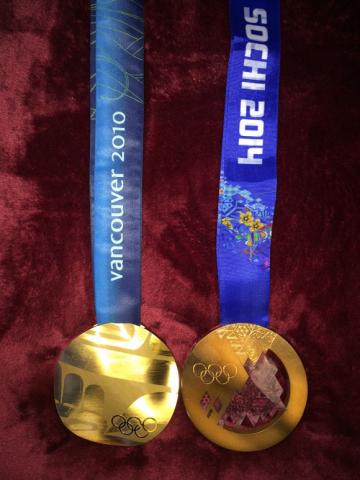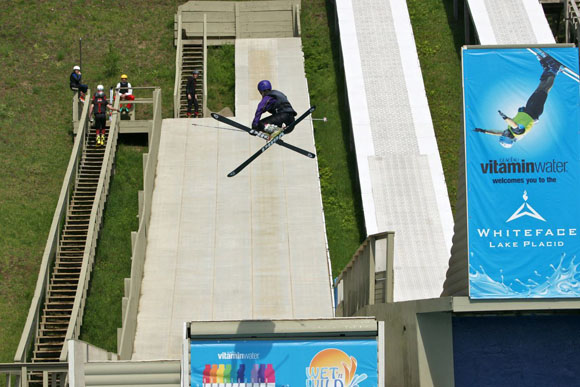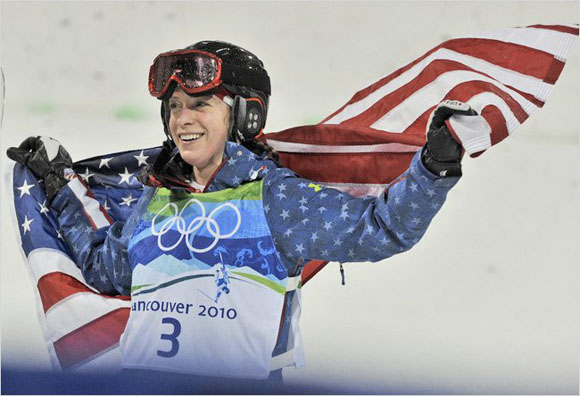National Champion. World Cup Champion. Olympic Gold Medalist. These are just a few of the titles Hannah Kearney earned over the course of her athletic career. While there’s no exact formula for success, Kearney learned a thing or two along the way. She shares six of the most important tips that helped her become one of the best mogul skiers ever.
You can’t succeed in this sport without help.
This is an individual sport. When you win, they only give you one medal, and you’re the one who’s earned it. But I’ve relied on a lot of people throughout my career. The people who knew me when I was young and said I would make it to the Olympics, before I even believed it, helped set the path for me. There’s a lot that goes on behind the scenes at the U.S. Ski and Snowboard Association, too. I have been incredibly supported by the sports science department, as well as the partnership with the United States Olympic Committee and the Olympic Training Center in Lake Placid. All of these little things played a part helping me be the best athlete I could be.

Kearney shows her two Olympic medals—a gold from the 2010 Vancouver Winter Olympics and a bronze from Sochi in 2014.
6,000 water ramp jumps can improve the squareness of your layout by a few degrees. And it’s worth it.
When you compete in a sport at a high level, changes don’t happen quickly. And little changes take a lot of work, especially when you’re correcting a bad habit. I never wanted to do backflips on snow, and it was something I struggled with. But I took the initiative to learn it and perfect it as much as I could. And the only way to do that was to break it down in to steps and try it on the water ramps.

Kearney spent many summers water ramping at the Olympic Jump Complex in Lake Placid, NY.
There is no point in complaining about the things you can’t control.
You’re going to have days where you feel like you aren’t “in the zone.” I had days where I felt like that and I still skied well, and other days when I skied poorly. After a while, I realized it didn’t matter. No matter how I felt, I was still capable of skiing well. You have to hold yourself accountable. How you react to a mogul course, the judges, the weather and travel is your choice.
Check-in mazes at the airport are not designed for ski bags.
Traveling was one of the hardest things for me. One of the best gifts I ever got was a scale to weight your bags, so you don’t have to shuffle goods from one bag to another to make the weight even. Dress in layers. It’s hot dragging your two 50-pound bags across the airport, but if you get a window or aisle seat it’s going to be freezing. Earplugs are key to have for flights and when you have roommates on the road.
Never say never. As an 11-year-old, I said I would never do a flip on snow – with conviction.
If you begin mogul skiing now, you know what’s expected of you as far as tricks go. But when I started the sport, I had no intention of doing backflips. I was 16 when they changed the rule about going inverted. It was a difficult age to learn backflips, and I just wasn’t really that interested in it. But I loved the sport enough to try. There’s a lot of reward in doing something that scares you. It was a little bit sketchy at first, but improving and having a good layout in my run is one of the things I’m most proud of.
Set goals. Once achieved, set a loftier one.
I’ve always naturally been a goal-setter. I like to make lists. In our introductory packet at the 2010 Olympics in Vancouver, they gave us a card where you were supposed to write a message to yourself or a goal on it. I wrote that I was ready to win, and I kept the card in my pocket throughout the games. I didn’t necessarily win the Olympics because I wrote it down, but it helps. Writing things down makes them seem more real.

The back of Kearney’s card at the 2010 Olympics, setting her goal to win a gold medal.
Winning that gold medal in 2010 was redemption for me. The 2006 Olympics was a miserable experience. I felt embarrassed, which is a strange feeling for an athlete to have. After 2006, I felt like I didn’t want to do this sport anymore. My knee surgery came at a key time, because as soon as I was taken away from the sport, I thought, “No, I can come back and do it better.”
The Olympics is about performing the run you want in a very small moment when it matters the most. That’s where the pressure comes from. Oddly enough, I didn’t feel the pressure in 2010. That helped me ski better. It was very surreal. Before I even heard the result, I felt like I had done what I was supposed to. It’s an experience I will always remember.

